
The gastrointestinal tract is the tract or passageway of the digestive system that leads from the mouth to the anus. The GI tract contains all the major organs of the digestive system, in humans and other animals, including the esophagus, stomach, and intestines. Food taken in through the mouth is digested to extract nutrients and absorb energy, and the waste expelled at the anus as faeces. Gastrointestinal is an adjective meaning of or pertaining to the stomach and intestines.

The Guggenheim Museum Bilbao is a museum of modern and contemporary art in Bilbao (Biscay), Spain. It is one of several museums affiliated to the Solomon R. Guggenheim Foundation and features permanent and visiting exhibits of works by Spanish and international artists. It was inaugurated on 18 October 1997 by King Juan Carlos I of Spain, with an exhibition of 250 contemporary works of art. It is one of the largest museums in Spain.
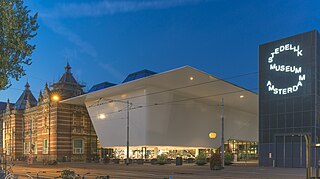
The Stedelijk Museum Amsterdam, colloquially known as the Stedelijk, is a museum for modern art, contemporary art, and design located in Amsterdam, Netherlands.
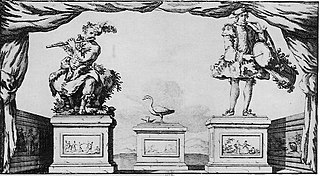
The Canard Digérateur, or Digesting Duck, was an automaton in the form of a duck, created by Jacques de Vaucanson and unveiled on 30 May 1764 in France. The mechanical duck appeared to have the ability to eat kernels of grain, and to metabolize and defecate them. While the duck did not actually have the ability to do this—the food was collected in one inner container, and the pre-stored feces were "produced" from a second, so that no actual digestion took place—Vaucanson hoped that a truly digesting automaton could one day be designed.

Wim Delvoye is a Belgian neo-conceptual artist widely recognized for combining in his inventive and often shocking projects philosophical ideas, innovative use of materials, and a passion for craftsmanship. He blurs the boundaries between traditional art and the digital realm of contemporary artistic practices, creating aerodynamic, mathematically precise, and intricate sculptures that take the art and design to new levels of invention, while offering a perceptive and playful commentary on contemporary society. As the critic Robert Enright wrote in the art magazine Border Crossings, "Delvoye is involved in a way of making art that reorients our understanding of how beauty can be created". Wim Delvoye has an eclectic oeuvre, exposing his interest in a range of themes, from bodily function, and scatology to the function of art in the current market economy, and numerous subjects in between. He lives and works in Ghent (Belgium).

EGG, the arts show is an American nonfiction television program that aired on PBS from January 13, 2000 to April 8, 2005. EGG documented both the famous and the unusual aspects and projects of classical and modern arts; its narrator was Elaine Stritch.

The Madison Museum of Contemporary Art (MMoCA), formerly known as the Madison Art Center, is an independent, non-profit art museum located in downtown Madison, Wisconsin.

Contemporary Arts Museum Houston is a not-for-profit institution in the Museum District, Houston, Texas, founded in 1948, dedicated to presenting contemporary art to the public.

Arnold Zimmerman (1954-2021), also known as Arnie Zimmerman, was an American sculptor and ceramic artist. His work ranged from monumental to miniature, and abstract to figurative, encompassing totemic vessel forms, tabletop sculpture and figures, murals, and room-size installations. He was part of a multi-decade, 20th-century shift in American ceramics during which artists challenged clay's identification with function and craft, engaging fine-art domains such as emotional expression, social commentary, figuration and narrative. Zimmerman first gained recognition in the 1980s for deeply carved, architectonic sculptures characterized by rough physicality, rhythmic surfaces, gestural presence and Italian Romanesque influences. In the mid-1990s, he shifted to figurative work that critic Donald Kuspit wrote, examined the interaction of finite man and infinite matter, artist and creative work: "There is a sense of futility and folly as well as seemingly senseless idealism and innocence built into Zimmerman's parables of the all-too-human."
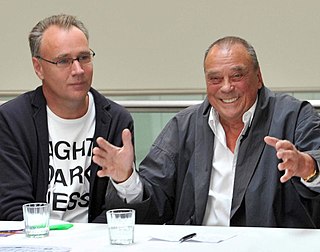
Mat(tijs) Visser studied architecture in Delft, the Netherlands and is since then an organiser of performances and art exhibitions. He was head of exhibitions at Museum Kunst Palast in Düsseldorf for eight years (2001–08), curated historical exhibitions and is best known for his Artempo exhibition at Palazzo Fortuny in Venice. He was the founding director of the international ZERO foundation in Düsseldorf from 2008 to 2017 and is a researcher at the Institute for Contemporary Archeology in Antwerp. As director from 0-projects he advises museums around the world on collection presentations.

The Museum of Old and New Art (MONA) is an art museum located within the Moorilla winery on the Berriedale peninsula in Hobart, Tasmania, Australia. It is the largest privately funded museum in the Southern Hemisphere. MONA houses ancient, modern and contemporary art from the David Walsh collection. Noted for its central themes of sex and death, the museum has been described by Walsh as a "subversive adult Disneyland".

Stratiformis is a public artwork by Korean-born artist Jin Soo Kim located in Catalano Square, which is south of downtown in the Historic Third Ward of Milwaukee, Wisconsin, United States. The large sculpture combines disassembled knitting machines culled from a local apparel manufacturer in a grid of rusted rebar, all hand-wrapped with galvanized and copper wire. It was installed in 2006.
Daniel Arango is a New York-based artist. He was born in Barranquilla, Colombia in 1982, and at age three his family fled Colombia’s civil war and moved permanently to Miami Beach, Florida, United States. He studied architecture and interior design, receiving a Master of Fine Arts degree in painting from Rhode Island School of Design in Providence, Rhode Island.

Isabelle Le Normand is a French contemporary art curator based in Los Angeles, California who has curated exhibitions and events internationally. After her double Master's from the Sorbonne in curatorial studies and art history, Le Normand curated for public institutions in Paris: at Mains d'Oeuvres where she was director and curator for six years; Palais de Tokyo; at Galerie Anne Barrault; La Box in Bourges; in Los Angeles at ForYourArt, Machine Project, and 18th Street Arts Center; at private collector Danny First's house and galleries Anne Barrault in Paris, FKSE in Budapest. She completed residencies at the Total Museum and Gwangju Biennale in South Korea, the Stroom Foundation in the Netherlands, Cité des arts in Paris, Komplot in Brussels, and Residency Unlimited in New York. At Mains d'Oeuvres she built a large audience and distinguished the space in the international arts community through innovative, multidisciplinary programming.
Kurt Hentschlager, or Hentschläger is a New York-based Austrian artist who creates audiovisual installations and performances. Between 1992 and 2003, he worked in a duo called Granular-Synthesis.
The Shit Museum is a museum in the province of Piacenza, in the north of Italy, and is reported to be the world's first museum dedicated to feces. The museum opened on 5 May 2015, having been founded by agricultural businessman Gianantonio Locatelli and three associates.
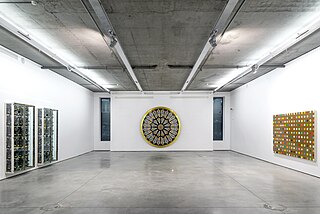
Gary Tatintsian Gallery (Tatintsian Gallery) is a prominent private collection and art gallery dedicated to showcasing leading figures in international contemporary art scene.
Kevin Beasley is an American artist working in sculpture, performance art, and sound installation. He lives and works in New York City. Beasley was included in the Whitney Museum of American Art's Biennial in 2014 and MoMA PS1's Greater New York exhibition in 2015.
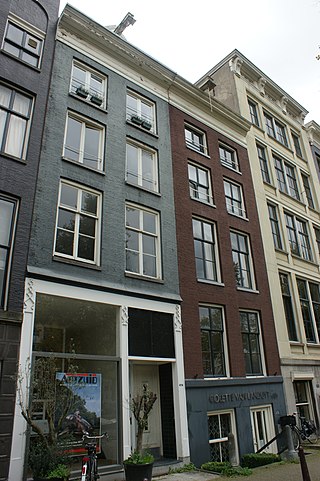
Galley Swart is a former Dutch gallery of Riekje Swart in Amsterdam from 1964 to 2000. The gallery promoted contemporary art of varies young art movements, and primarily wanted to arise interest for modern art.
Empathy and Prostitution is a conceptual and performative work of critical and biographical content by artist Abel Azcona. Azcona was inspired by his biological mother, a prostitute, and sought to empathise with her and with the moment of his own conception. Azcona offered himself naked to the galleries' visitors on a bed with white sheets, so that they could exchange intimacy or have sexual relations with him.


















